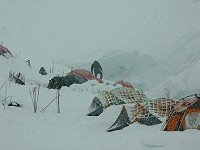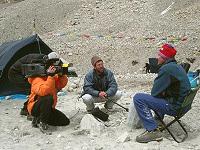| |
 |
Saint
Petersburg: JUBELEE
EXPEDITION "EVEREST 2003" | 5
May, 2003 Tom Masterson: Boredom
in base camp (but the weather has a field day). Here in base camp, the winds were
blowing 50-80 km/hr, with significantly higher gusts. Sand and dust screamed down
the moraine. Most folks were trying to put enough rocks around their tents that
they would stay there for the night and not
get totally shredded. One British
tent got blown a kilometer or so downstream and was rescued by one of their cooks,
who chased it all the way.
Several Chinese tents had problems and we helped
rescue one of them. One American tent started down moraine spewing contents along
the way with climbers in hot (if chilled) pursuit. Fine silt and sand had no problem
going straight through the walls.
Two more of our members went 50 km out along
the Everest Base Camp road to enjoy a bit of lower elevation and some fresher
food. People returning from the intermediate camp said that the wind and snow
were intense there. People coming down from the North Col and higher say that
many tents have not survived the storm at that altitude. Around the middle of
the night, the winds quieted for half an hour, and then picked up as intensely
as before but with a finer sound hitting the tent - yes - we were now in the middle
of a blizzard. That did afford a chance to shovel the dust out of the tent. The
snow stopped about 9 a.m. but soon returned as an intense blowing sandstorm.
We
re-anchored many tents as they again filled up with dust. The Indian group returned
from ABC where their kitchen and mess tents have been blown away. They tell us
that ours are still o.k., even though they are only separated by a few feet (and
supported by the same agency). Our chief is very worried about what might be happening
to all of our equipment and the
consequences for the entire expedition. Tomorrow
one of the agency staff responsible for tents and food will go up to check out
our ABC status. We will not be able to ascertain status on higher camps until
Thursday or Friday as the storm is expected to intensify for the next 3 days.
We
are able to make reasonably accurate summit wind speed estimates by measuring
the time it takes a cloud starting at the summit to traverse the 2 km summit ridge
line. Today, after things opened up a bit, the speed was about 150 km/hr! In base
camp, cooks try to make food edible but somehow
everything has the flavouring
of sand or silt.
Many climbers visit other base camps. The St. Petersburg camp
seems to be known for its hospitality if not for its cooking. Last evening, with
2 of our 9 absent, we had 14 in the tent. The sharing of BC resources is common
and appreciated (especially battery chargers). Our power generator is one of the
few that has functioned reliably amongst all the smaller expeditions.
But the
face of base camp has changed immensely over the past few years. The mess-tent
is humming with ultra-sophisticated equipment. Our chief, Tolya, is an excellent
photographer, has a very fancy digital camera, and is always
sorting through
and editing his photos as well as documenting the expedition in Russian. Another
climber is trying to keep a powerbook operational and send out e-mail through
an Iridium system (which seems to work much better for voice than for digital).
Someone else is transmitting photos and web videos through a Bgan/Inmarsat system
as well as editing the web videos on site. And almost everyone has sent and received
e-mail. All this has enabled our expedition leader, Andrey Ershov, to keep the
Everest web site
(http://www.ersh.sp.ru/news/evrst.html) quite up-to-date.
Most of the computer systems seem to be at their limit of operational capabilities.
A great deal of time has been spent getting and keeping them operational and none
have gone above base camp. The British Navy group found that none of
their
Panasonic hard drives would work at this (5100 m) elevation and had to specially
order in hard drives that would work here. All-in-all, base camp today is quite
a contrast to a few years ago when we were quite happy for gas lanterns, candles,
and radio-telephone communication within the group. This FM radio-telephone has
not gone away.
It is used extensively when line-of-sight communication is possible
and usually limited to 1 W broadcasting power, and done at pre-arranged times
during the day to keep batteries from expiring too soon. It is also still usually
more reliable and much cheaper than a satellite phone link. However, when line-of-sight
is not available, even those with five times as much
power cannot establish
communication.
What else has been going on in this 2.5 m x 3 m tent today?
Dr. Dima was operating on someone from another camp even though under the effects
of wind and altitude all day himself. And, of course, the world's social, economic
and political problems were being solved by fiat, manifesto, and "I told
you
so". And the wind blows, and blows, and blows.
4
May, 2003 Marina
Ershova: Hello,
Today
I have descended from the North Col with Oleg Nasedkin. It is impossible strong
wind there! A part of the tents was destroyed of flown away! Now we are at BC
and all is OK. Maybe tomorrow we will go to the nearest village for rest. 
 on the way to the North Col
workdays on the North Col
on the way to the North Col
workdays on the North Col

 Nikolay Totmyanin and American TV
our neighbours like our doctor
Nikolay Totmyanin and American TV
our neighbours like our doctor
All
pictures by Anatoly Moshnikov.
| | |




 on the way to the North Col
workdays on the North Col
on the way to the North Col
workdays on the North Col 
 Nikolay Totmyanin and American TV
our neighbours like our doctor
Nikolay Totmyanin and American TV
our neighbours like our doctor